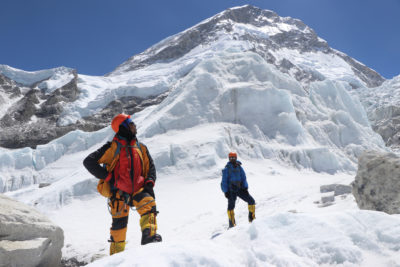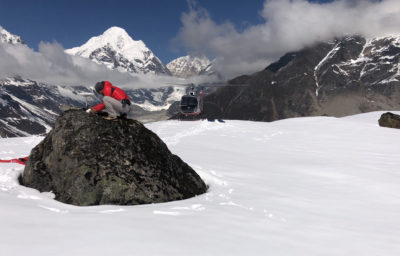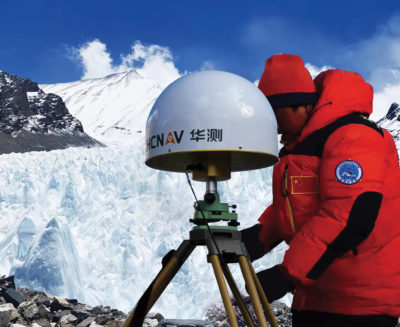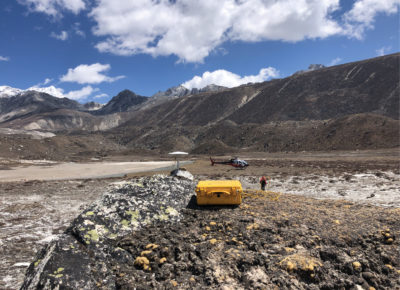
Khim Lal Gautam and Rabin Karki at the Ice Fall of Everest. Gautam looking ahead to find the best route through the Ice Fall. In April of 2014, 16 Climbing Sherpas lost their lives in an avalanche in this area. Background: Lola Pass and Peak, just south of the Everest summit, at about 21,000 feet above mean sea level.
Determining the elevation of the world’s most famous mountain is not as simple as taking a GNSS receiver to the summit. The newest elevation measurements involved far more: advances in GNSS, refinements in regional geodesy, and intrepid surveyors who faced perilous conditions
“We faced weather problems and wind turbulence at the South Col, our last stop before the summit on May 20, 2019. And we discovered there were not enough oxygen bottles stored at the South Col for us, due to the negligence of the expedition-operating company who had the responsibility for managing oxygen and other accessories. The main Sherpa of the team, Tshiring, told me that the mission was almost impossible and requested me to descend to the second camp. Having previously climbed Mount Everest, I knew that the mission would fail if we descended. I felt heart-broken at the prospect of giving up. I said to Tshiring, “No! I cannot give up this historic mission at this final moment.”—Chief Survey Officer Khim Lal Gautam, Survey Department of the Government of Nepal

To access this extreme terrain, a helicopter transported surveyors to set a GNSS reference station antenna on this bolder near Mount Makalu, at about 13,000 feet above mean sea level. This is the area of Makalu Barung National Park, Sankhuwashabha district.
Gautam and his team would continue up the mountain, by borrowing additional oxygen bottles. His team and their equipment performed flawlessly during the limited window for measurements despite brutal conditions on the summit. Gautam would also face a near-death situation during the descent—his first-hand account follows. But there is a backstory to this historic survey that began with broader geodetic goals in mind. GPS and GNSS receivers have been carried to the summit on many previous occasions, but never before by two successive survey teams from two countries, with the surveys registered to newly refined geodetic models and reference frameworks, and the results jointly released.

There were two surveys: the Nepal survey in 2019, and the Chinese survey, shown here at the summit in May of 2020. The GNSS antenna is at the top of the rod along with some prisms and flagging.
Recently announced by China and Nepal, the latest elevation for Mount Everest is more than just a number; it represents the culmination of more than 150 years of progressive advances in surveying methods and technologies since the mountain was first measured. The quality of the results is a function of how well the geodetic models of the region and earth have been refined. Few such technical details have been discussed in mainstream news since the announcement of the new elevation, but surveyors know there is more to such an endeavor than a climb and GNSS session.
The Arc of Time
The Great Trigonometrical Survey of India spanned the years—in one form or another—from 1802 to 1871. It sought to measure and define on the ground a single arc of longitude from the southern tip of India to northern reaches in the Himalayas; this was to serve as a baseline for mapping and surveying of the (then) British Colony. A series of towers were erected along the route and 400-pound theodolites were hauled by crews that sometimes numbered in the hundreds. While reducing triangulation notes in 1852, an office technician noted that one peak (known simply as PEAK XV at the time) appeared to be the tallest ever recorded, at 29,002 feet. While the peak already had several local names, it was christened “Mount Everest” in honor of Sir George Everest, the survey leader at the time.
Optical instruments and triangulation were the only practical methods for determining an elevation of the mountain at the time. Since, instruments have gotten lighter and reference marks were established closer into the peak, but for over a century the method and tech changed little—until GPS came along. In the 1990’s, GPS was brought to the summit on several occasions, mostly Trimble systems at the time, and the company has continued to provide equipment for many of the subsequent surveys.

For the Chinese survey in 2020, a network of temporary CORS was also set up around the mountain. In an unrelated development, the first 5G service was established near the mountain around the same time which aided in team communications.
Notable among these surveys was the 1998 American Mount Everest Expedition, which explored multiple scientific goals: GPS played a part in these as well. In 1998, Charlie Trimble, (founder and president of the company that bears his name) said, “The work being done on the mountain can help us understand more about the world around us, how it changes and how the body works,” “This information can be applied to everyday life. The science on the mountain above 29,000 feet will have value to those of us who live at sea level.” Four American researchers climbing Everest were fitted with bio-paks recording how their bodies reacted to the environment. That information, coupled with positioning data from the GPS receivers, provided researchers at the base camp with the most detailed information ever compiled on the effects of altitude and climbing. On the survey side of the expedition, GPS data was collected at four points on the mountain—Kala Pattar, Base Camp, South Col, and the Summit—to precisely track the slow geological movements of the mountain over time.
In 1999, the U.S. National Geographic Society expedition determined, with Trimble gear, an elevation of 29,035 feet, but in such early GPS surveys of the summit the precision was stated as +/- 6 feet (a mix of expected error and geodetic reference uncertainty). Other surveys concurred closely in 2005, 2013 and 2015. During this same period, multiple entities such as the USGS and the science non-profit UNAVCO established reference stations throughout the region to study earthquakes and plate tectonics. These stations also provided reference data for post-processing of several summit surveys.

An extensive network of GNSS observations were done to support the update of the geodetic reference framework for the area. A Trimble R9 receiver and Zephyr Geodetic antenna at SILICHE, Sol Khumbu, Eastern Nepal, the Southern part of the Mt Everest.
As we know, GPS/GNSS only yields an ellipsoid height; a geoid model, derived from gravity observations, must be applied to derive an elevation. Any elevation determination has to also take into account a geodetic reference, and in the case of the earliest measurements, this might involve carrying reference elevations from distant shores. Over many decades, gravity meter measurements were mixed in with GNSS campaigns. Airborne and satellite gravity (i.e., GRACE and GOCE missions) also helped refine the geoid models. Yet there was still some disagreement as to an official elevation, as some say the true point is the apex of the rock, and others the highest point of the ice above it. To determine the top of the rock beneath the ice, ground penetrating radar (GPR) must be deployed, as it has on several occasions.
Fast forward to December 8, 2020, when the results of two surveys—29,031.69 feet—represented a gain of about 2 feet over the widely accepted previous elevation. The Sagarmatha (Everest) Height Measurement project, undertaken by the Survey Department of Nepal, summited in May of 2019; the Department of Land Surveying and Mapping of the Ministry of Natural Resources of China climbed a year later. Each team established networks of GNSS reference stations nearby, brought high-precision GNSS and GPR to the summit, and could now process the observations aligned to modernized reference frameworks. The science and technology had advanced to the point where this dual effort could yield the most precise elevation to date, but it all hinged on some hearty surveyors and Sherpas performing one-shot rapid surveys on a perilous mountain.
Drivers

GNSS Antenna at the base of Kalapahhar, about 17,500 feet above mean sea level. One of the temporary project CORS stations, it is 8km from the summit.
The deadly earthquake that struck the Himalayas in 2015 brought with it fears for the stability of the mountain. And indeed, much of the chatter about these two surveys mentioned the earthquake as the main driver, yet this is not entirely true. Multiple studies using satellite-based radar and optical triangulation surveys of the mountain indicate there was minimal deformation. It had more to do with a desire to modernize the geodetic infrastructure of Nepal and build in-house expertise and stewardship of the mountain, which saw the ambitious campaign by the Survey Department of Nepal begin several years ahead of the eventual summit measurement. With this modernization, Nepal would become the foremost expert on the geodesy of the mountain and the region. This is a source of national pride as they had previously relied a lot on outside entities for such expertise.
Less is known about the drivers for the Chinese survey, but it was something that had been planned for many years. A diplomatic visit to Nepal in late 2019 by Chinese leader Xi included discussion about a minor disagreement about the elevation of Everest. Nepal had just completed their survey, and China had theirs in the works. The two countries agreed to delay announcement until both were complete and the respective surveying entities could come up with an agreed value.
Gear
Again, as for past surveys, Trimble stepped up to provide gear for the summit as well as the geodetic network. “Trimble India provided us a NetR9 base receiver, two R10 (GNSS rovers) for the survey of the peak, DiNi digital levels, S9 total stations that we used to measure our baselines for the reference network, and TBC (Trimble Business Center Software) for GNSS post-processing,” said Susheel Dangol, the coordinator and Chief Survey Officer of the Sagarmatha Height Measurement Secretariat.
“We established a network of 298 survey marks around the area of the mountain and did gravity measurements and GNSS on each,” said Dangol. “[Trimble] DiNi digital levels and trigonometric leveling with total stations were used to establish precise elevations on a subset of these marks to serve as primary points. And we did GNSS observations on each for horizontal positions.”
Eight temporary continuous operating reference station (CORS) receivers were set up on and around the mountain at elevations between 16,000 to 20,000 feet—several by helicopter. This campaign was long static sessions, constraining to the national CORS network. Nepal’s CORS network was built in cooperation with the international scientific community to study the plate tectonics of the region. This large-scale geodetic undertaking was phased over multiple years and an estimated final cost of nearly $1.3 million.
Nepal Survey says they were pleased with the R10 GNSS rover chosen for the summit; they found it light, compact and had no issues during the climb and numerous training and test sessions. Reliability was key; they would only get one chance in the narrow time window at the summit. The R10 weighs just over 2.25 lbs. and operates in temperatures as low as -40°F, a good fit for Everest’s summit at 3:00am in May.
The Chinese team also set up a CORS network using a mix of multiple manufacturers’ gear. It was reported that several different Chinese rovers were carried to the top, though only one has been confirmed by name (a P5 from CHC Navigation). One of the few photos released by China shows a GNSS antenna on a rod, along with what appears to be an array of prisms (and a lot of flagging for visibility from afar). It is highly likely that laser measurements were also employed.
Both teams collect just under 2 hours each of GNSS observations, but with multiple constellations, providing robust post-processing results.
The Nepal Team Climb
Chief Survey Officer Khim Lal Gautam, Survey Officer Rabin Karki, lead Sherpa Tshiring Jangbu and two additional Sherpas set out up the mountain, choosing the South Col route. The most popular route, it’s the same one Sir Edmund Hillary and Tenzing Norgay took for the first ascent in 1953. This was Gautam’s second ascent, having been the principal of the “Nepal Civil Servant First Mount Everest Expedition” in 2011.
May is one of the best months to climb, making it also the most crowded time on the mountain; there can be backups of climbers near the summit. For this reason, Gautam chose to make the final push in the middle of the night, so they could have the small summit area to themselves to do the GNSS and GPR measurements.
“By the morning of May 21, we were able to arrange for the required additional oxygen at the South Col, with the help of other Sherpas,” says Gautam. “At around 2 PM the same day, I decided to start our final journey from South Col to the summit. I knew it usually took climbers 10 to 15 hours to reach the peak of Mount Everest from South Col depending on the strength of the climbers.”
“When we summited Everest at 3:00am, initially there were no other climbers,” said Gautam. “The first climbers we met were two Polish climbers. About halfway through our GNSS measurement, we witnessed a large crowd of climbers approaching.” The impending crowd and the harsh conditions meant for a narrow window for measurements.
Measurements
One of the two Trimble R10’s was set up on a mini-tripod with a quick-release attachment. “The tripod was specially designed by me to work on Everest,” says Gautam. “This tripod is lightweight and short, allowing for greater stability in the wind. It had a locally designed special type of metal screw, one foot long, enabling us to fix it in the packed snow at the summit.”
Working on the top of Everest is a challenging task; the conditions were rough throughout, but thankfully, the conditions did not deteriorate further during their work. The direction of the strong winds was random, so to further stabilize the tripod the team took turns laying down on the snow to hold it.
The R10 had been pre-configured to begin recording static observations on power-up, as removing heavy gloves to operate a controller keyboard could be dangerous. Unfortunately, lighter gloves were required to operate the data controller of the GPR receiver, which contributed to the frostbite that some of the team experienced. “The area of the summit is about five to six meters from side to side,” says Gautam. “We did not have any difficulties with the GNSS or the GPR: the instruments were carried in insulated bags and we did not have to charge any batteries. There was a fully charged battery in the R10 and we had spares.”
While the R10 GNSS was collecting data, they performed the GPR observations to determine the depth of the snow and ice on the summit at that time. The GPR was a Geophysical Survey Systems, Inc. (GSSI) SIR 4000, provided by the U.S. National Geographic Society. They scanned the surface around the top, an area of about 50-70 square feet, for about 10 minutes.
After having worked for about two hours, the crowds of climbers approaching the summit increased and it was difficult to deter them from coming near the working area, and they had limited supply of oxygen, they decided to descend. In many ways, the decent can be the most dangerous part of the climb; the climbers are exhausted from a long day in the “death zone” above 24,600 feet. Up until that point the team had fared quite well, apart from fatigue, numbness, and some cyanosis (a level of frostbite). But Gautam was about to face personal peril.
“I became unconscious at the altitude of around 27,000 feet and lay down on the blue ice near the South Col,” said Gautam. “I stayed unconscious for about two hours and only woke up after an unknown climber kicked me from behind—maybe he thought I was already dead. After I woke up, I found myself alone. As we were on the descent and near the camp, Tshiring possibly concluded that as we were in a less risky area, I was simply lagging behind and would come to the South Col eventually by myself. This long unconsciousness cost me part of the tip of my left toe forever, due to frostbite. Normally, when a climber loses consciousness and assistance is not timely, it is difficult to wake up again. Luckily, I woke up. I feel this was the miracle of my life.”
Due to weather conditions, the surveyors and Sherpas would spend a total of three nights above the death zone—usually climbers spend only one. But without further incident, they returned safely.
Joint Announcement
On December 8, 2020, a live virtual announcement event was held. Representatives from Nepal and China simultaneously tapped keys and the new elevation appeared on the shared screen: 8,848.86m (29,031.69 feet). It had been over 18 months since the Nepal survey, and more than six months since the Chinese survey. And while there were certainly technical details to work out between the two teams, like geodetic references, much of the delay was likely due to planning the details and messaging for the joint announcement.
“There has been splendid coordination between all of our people,” said Dangol. “We have very hard-working teams who had to survey in harsh conditions. Much of the fieldwork for the regional geodetic survey was also mostly at high altitudes and in inclement weather. The project was a matter of national pride for Nepal and a prestigious undertaking for the Nepali government. I feel very proud that we were able to complete it successfully. This is an amazing team.”
Gautam is honored to have been entrusted with leading the summit team and overseeing the survey. And indeed, it was his experience, commitment to the mission, and ability to act decisively that brought about the success of the Nepal survey. He says this expedition is a testament to the skill, tenacity and honor of surveyors worldwide. ◾
Jodie Hartnell is geographer, chef, and freelance writer. Born in the UK, Jodie studied geography on both sides of the Atlantic and has settled in beautiful British Columbia. @hartnelljodie